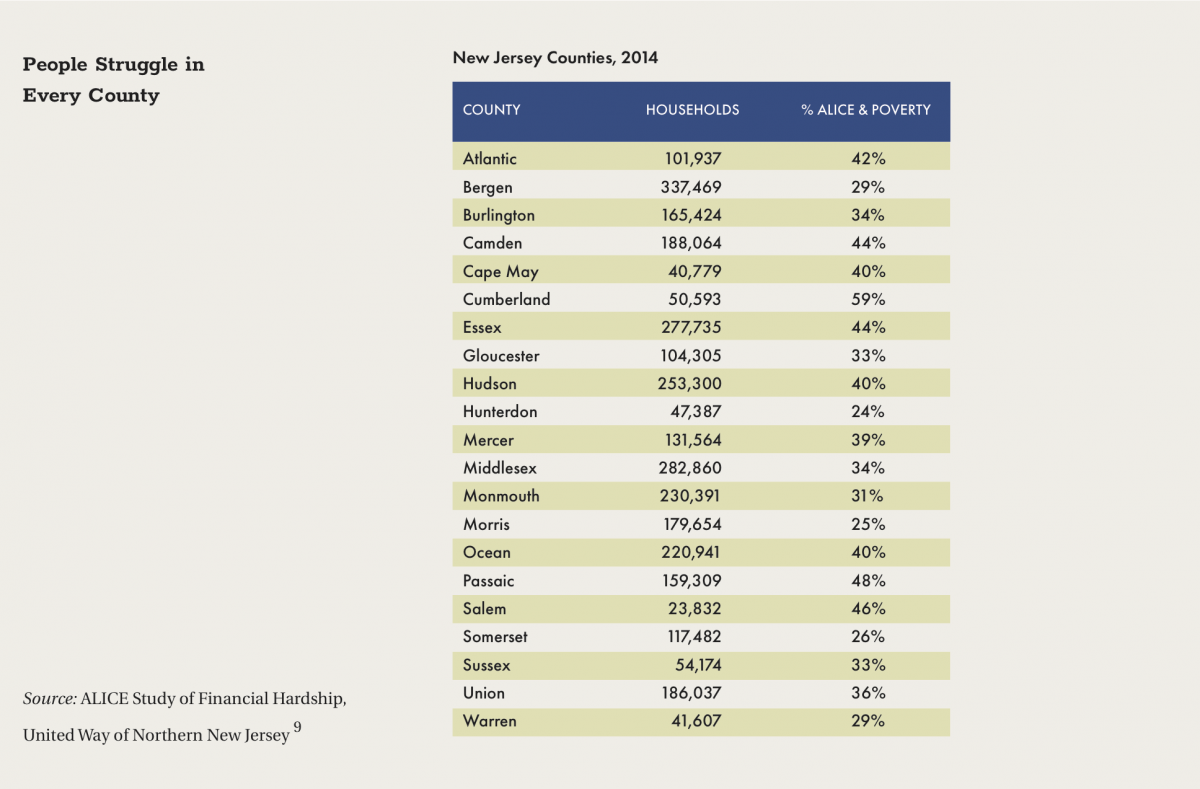Today’s New Jersey economy is a study in contrasts.
In a state with the nation’s second highest per capita income, millions of people struggle to make ends meet. The wealthiest 5% of households have 15.6 times the income of the bottom 20%, a gap exceeded in only five other states.
Only four states have a higher percentage of college graduates than New Jersey’s 37.6%; at the same time, 10.9% of residents over age 18 lack a high school diploma.1
New Jersey is seventh nationally in the number of Fortune 500 companies and focuses its job-creating strategies on large corporations; yet, small businesses employ more people. These businesses often struggle to get capital.
For policymakers, the task of extending to everyone the opportunities that many enjoy means coming to terms with the difficulties of getting by on low pay in a state where the cost of living is significantly higher than the national average.
Although employment in New Jersey has rebounded from the 2008 recession, jobs continue to grow more slowly than in neighboring states and in the U.S. on average.2 The October 2016 employment numbers showed that New Jersey had recovered 99% of jobs lost in the recession, but that is not as impressive as it might sound: in the nation as a whole, jobs surpassed pre-recession levels by 76%.3 New Jersey’s job growth was the nation’s eighth slowest.
Just over 4.3 million New Jersey men and women are employed; the state’s 4.1% unemployment rate, as of May 2017, was slightly below the national level of 4.3%.4
At more than $72,000, the median annual wage in New Jersey is significantly higher than in the nation overall. While this is chiefly due to a significant number of high-wage jobs, even jobs at the low end of the income scale are slightly higher-paying than equivalent employment in the rest of the country—though not enough to meet the state’s living costs.5
There are various ways to measure economic distress. One approach focuses on the fact that 24.7% of the people who live in New Jersey meet the federal government’s classification of “low-income,”6 making no more than twice the federal poverty level. (In 2016, the low-income level was $40,320 for a family of three, and $48,600 for a family of four.) Another measure uses the federal poverty level itself ($20,160 a year for a family of three), even though it is widely viewed as outdated because it underestimates how much it takes for a family to meet basic needs and build for the future. Overall, 10.7% of New Jerseyans, and more than 15% of children,7 fall below the federal poverty level. The child poverty rate increased by 7% from 2011 to 2015—making New Jersey one of only two states with worsening child poverty rates during a four-year national trend of modest improvement.8
A major shortcoming of federal poverty and income classifications is that they do not account for state-to-state differences in the cost of living. The yearly income levels that constitute federal poverty or low-income status are the same in all 48 contiguous states. A more meaningful measure was developed by The United Way of Northern New Jersey, partnering with the Rutgers University-Newark School of Public Affairs and Administration. This measure of economic security, called ALICE (for “Asset-Limited, Income-Constrained, Employed”—a description of working families who struggle for economic traction) considers New Jersey’s high cost of living and accounts for county-by-county variations. By this measure, 37% of New Jersey households earn too little to provide for necessities, and in no county is the figure below 24%. People at this level of income struggle from paycheck to paycheck, making less than the “survival budget” of $64,176 a year that a family of four would require. A survival budget means enough money to afford a two-bedroom apartment at fair market rate, maintain one car, and pay for licensed in-home child care, food, out-of-pocket medical expenses, and taxes, plus an additional 10% of the total of all these items in case of overruns.

Economic well-being in New Jersey strongly correlates with race and ethnicity. The African-American poverty rate of 18.6% and Hispanic poverty rate of 20.2% are both more than double the 8.2% rate of poverty among whites in the Garden State.10 More than 15% of the state’s African-American children and 12% of Hispanic children live in what is classified as “deep poverty”—less than half of the federal poverty level, which means less than $12,150 in annual income for a family of four. Only 3% of non-Hispanic white children live in such households.11
Contrary to conventional wisdom, economic insecurity is not a predominantly urban issue. While urban Hudson County’s percentage of 40% ALICE households is above the state average, the rate in largely rural Cumberland County is the highest in the state, 59%. Economic vulnerability affects all regions of New Jersey.12
Like the rest of the United States, New Jersey faces a future of new jobs that will pay less than the jobs they replace. The high-cost state is expected to see a large growth of new jobs in the relatively low-wage service sector. Of the eight job categories with the largest projected growth in employment by 2024 (76,850 jobs), six are lower paying occupations such as home health aide, food preparation and service, retail sales, and laborers and hand movers.13
These jobs can be the first rungs of the ladder into the middle class for many people if the state adopts policy solutions that effectively address barriers to employment, and if wages keep up with living costs. Without supportive public policy decisions, these jobs will be dead ends.